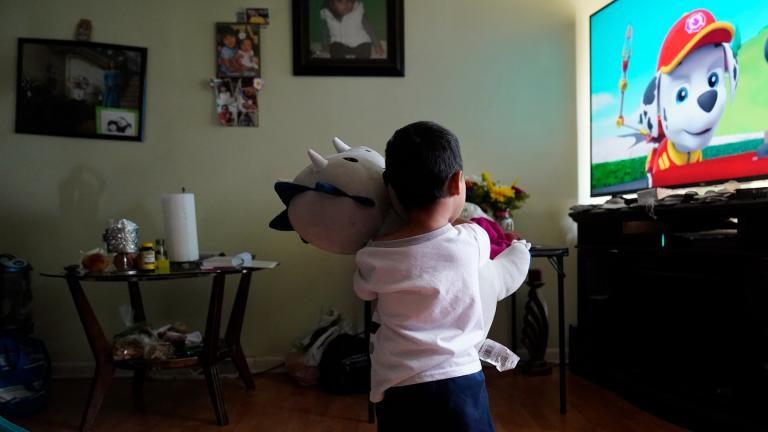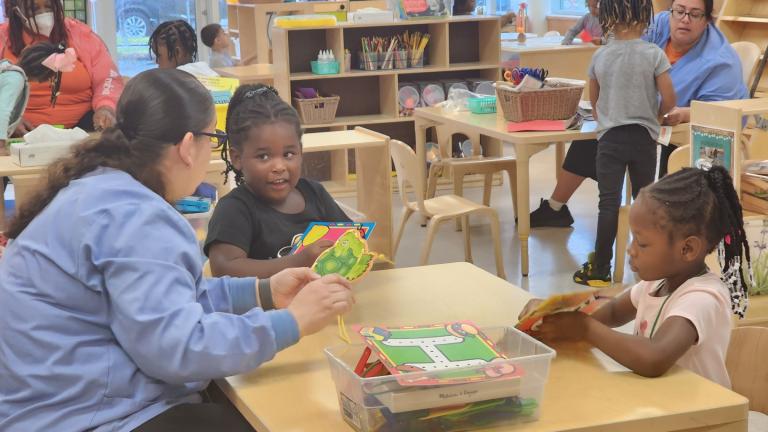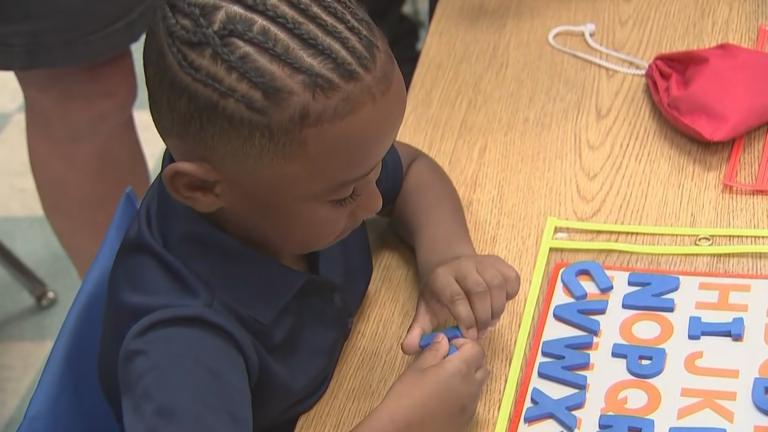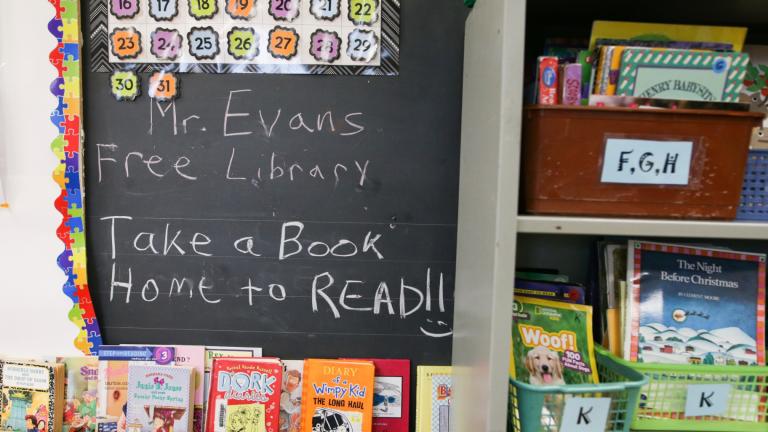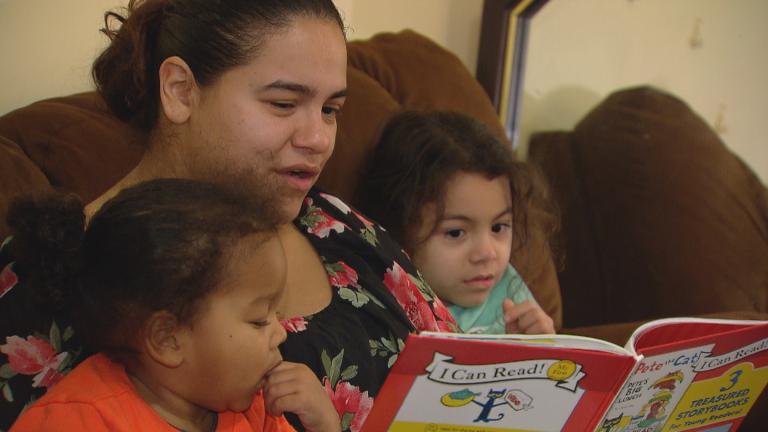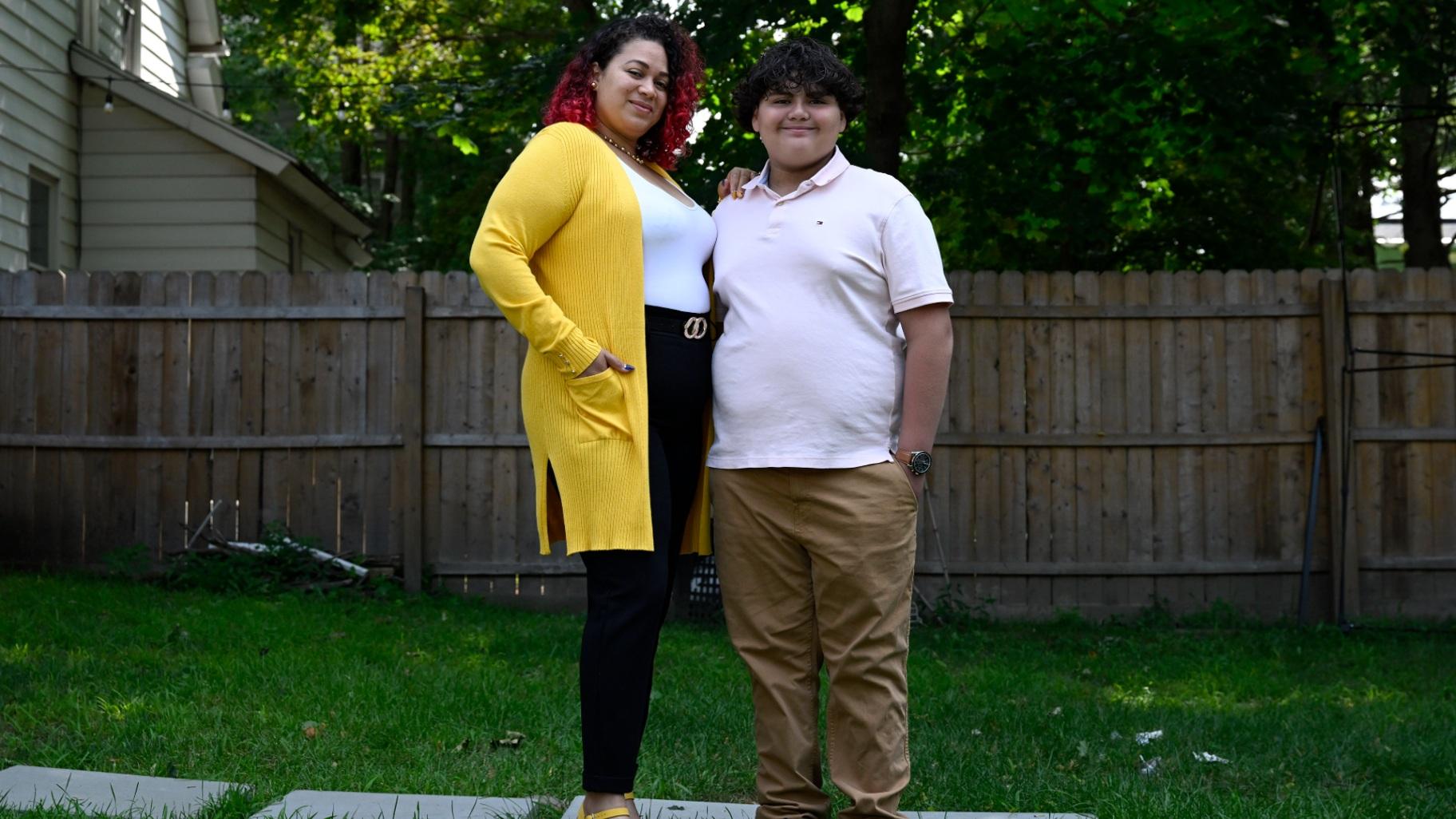 Rousmery Negrón stands with her son at home in Springfield, Mass., on Thursday, Aug. 3, 2023. (Jessica Hill / AP Photo)
Rousmery Negrón stands with her son at home in Springfield, Mass., on Thursday, Aug. 3, 2023. (Jessica Hill / AP Photo)
SPRINGFIELD, Mass. (AP) — When in-person school resumed after pandemic closures, Rousmery Negrón and her 11-year-old son both noticed a change: School seemed less welcoming.
Parents were no longer allowed in the building without appointments, she said, and punishments were more severe. Everyone seemed less tolerant, more angry. Negrón’s son told her he overheard a teacher mocking his learning disabilities, calling him an ugly name.
Her son didn’t want to go to school anymore. And she didn’t feel he was safe there.
He would end up missing more than five months of sixth grade.
Across the country, students have been absent at record rates since schools reopened during the pandemic. More than a quarter of students missed at least 10% of the 2021-22 school year, making them chronically absent, according to the most recent data available. Before the pandemic, only 15% of students missed that much school.
All told, an estimated 6.5 million additional students became chronically absent, according to the data, which was compiled by Stanford University education professor Thomas Dee in partnership with The Associated Press. Taken together, the data from 40 states and Washington, D.C., provides the most comprehensive accounting of absenteeism nationwide. Absences were more prevalent among Latino, Black and low-income students, according to Dee’s analysis.
The absences come on top of time students missed during school closures and pandemic disruptions. They cost crucial classroom time as schools work to recover from massive learning setbacks.
Absent students miss out not only on instruction but also on all the other things schools provide — meals, counseling, socialization. In the end, students who are chronically absent — missing 18 or more days a year, in most places — are at higher risk of not learning to read and eventually dropping out.
“The long-term consequences of disengaging from school are devastating. And the pandemic has absolutely made things worse and for more students,” said Hedy Chang, executive director of Attendance Works, a nonprofit addressing chronic absenteeism.
In seven states, the rate of chronically absent kids doubled for the 2021-22 school year, from 2018-19, before the pandemic. Absences worsened in every state with available data — notably, the analysis found growth in chronic absenteeism did not correlate strongly with state COVID rates.
Kids are staying home for myriad reasons — finances, housing instability, illness, transportation issues, school staffing shortages, anxiety, depression, bullying and generally feeling unwelcome at school.
And the effects of online learning linger: School relationships have frayed, and after months at home, many parents and students don’t see the point of regular attendance.
“For almost two years, we told families that school can look different and that schoolwork could be accomplished in times outside of the traditional 8-to-3 day. Families got used to that,” said Elmer Roldan, of Communities in Schools of Los Angeles, which helps schools follow up with absent students.
When classrooms closed in March 2020, Negrón in some ways felt relieved her two sons were home in Springfield. Since the 2012 shooting at Sandy Hook Elementary School in Connecticut, Negrón, who grew up in Puerto Rico, had become convinced mainland American schools were dangerous.
A year after in-person instruction resumed, she said, staff placed her son in a class for students with disabilities, citing hyperactive and distracted behavior. He felt unwelcome and unsafe. Now, it seemed to Negrón, there was danger inside school, too.
“He needs to learn,” said Negrón, a single mom who works as a cook at another school. “He’s very intelligent. But I’m not going to waste my time, my money on uniforms, for him to go to a school where he’s just going to fail.”
For people who’ve long studied chronic absenteeism, the post-COVID era feels different. Some of the things that prevent students from getting to school are consistent — illness, economic distress — but “something has changed,” said Todd Langager, who helps San Diego County schools address absenteeism. He sees students who already felt unseen, or without a caring adult at school, feel further disconnected.
Alaska led in absenteeism, with 48.6% of students missing significant amounts of school. Alaska Native students’ rate was higher, 56.5%.
Those students face poverty and a lack of mental health services, as well as a school calendar that isn’t aligned to traditional hunting and fishing activities, said Heather Powell, a teacher and Alaska Native. Many students are raised by grandparents who remember the government forcing Native children into boarding schools.
“Our families aren’t valuing education because it isn’t something that’s ever valued us,” Powell said.
In New York, Marisa Kosek said son James lost the relationships fostered at his school — and with them, his desire to attend class altogether. James, 12, has autism and struggled first with online learning and then with a hybrid model. During absences, he’d see his teachers in the neighborhood. They encouraged him to return, and he did.
But when he moved to middle school in another neighborhood, he didn’t know anyone. He lost interest and missed more than 100 days of sixth grade. The next year, his mom pushed for him to repeat the grade — and he missed all but five days.
His mother, a high school teacher, enlisted help: relatives, therapists, New York’s crisis unit. But James just wanted to stay home. He’s anxious because he knows he’s behind, and he’s lost his stamina.
“Being around people all day in school and trying to act ‘normal’ is tiring,” said Kosek. She’s more hopeful now that James has been accepted to a private residential school that specializes in students with autism.
Some students had chronic absences because of medical and staffing issues. Juan Ballina, 17, has epilepsy; a trained staff member must be nearby to administer medication in case of a seizure. But post-COVID-19, many school nurses retired or sought better pay in hospitals, exacerbating a nationwide shortage.
Last year, Juan’s nurse was on medical leave. His school couldn’t find a substitute. He missed more than 90 days at his Chula Vista, California, high school.
“I was lonely,” Ballina said. “I missed my friends.”
Last month, school started again. So far, Juan’s been there, with his nurse. But his mom, Carmen Ballina, said the effects of his absence persist: “He used to read a lot more. I don’t think he’s motivated anymore.”
Another lasting effect from the pandemic: Educators and experts say some parents and students have been conditioned to stay home at the slightest sign of sickness.
Renee Slater’s daughter rarely missed school before the pandemic. But last school year, the straight-A middle schooler insisted on staying home 20 days, saying she just didn’t feel well.
“As they get older, you can’t physically pick them up into the car — you can only take away privileges, and that doesn’t always work,” said Slater, who teaches in the rural California district her daughter attends. “She doesn’t dislike school, it’s just a change in mindset.”
Most states have yet to release attendance data from 2022-23, the most recent school year. Based on the few that have shared figures, it seems the chronic-absence trend may have long legs. In Connecticut and Massachusetts, chronic absenteeism remained double its pre-pandemic rate.
In Negrón’s hometown of Springfield, 39% of students were chronically absent last school year, an improvement from 50% the year before. Rates are higher for students with disabilities.
While Negrón’s son was out of school, she said, she tried to stay on top of his learning. She picked up a weekly folder of worksheets and homework; he couldn’t finish because he didn’t know the material.
“He was struggling so much, and the situation was putting him in a down mood,” Negrón said.
Last year, she filed a complaint asking officials to give her son compensatory services and pay for him to attend a private special education school. The judge sided with the district.
Now, she’s eyeing the new year with dread. Her son doesn’t want to return. Negrón said she’ll consider it only if the district grants her request for him to study in a mainstream classroom with a personal aide. The district told AP it can’t comment on individual student cases due to privacy considerations.
Negrón wishes she could homeschool her sons, but she has to work and fears they’d suffer from isolation.
“If I had another option, I wouldn’t send them to school,” she said.


